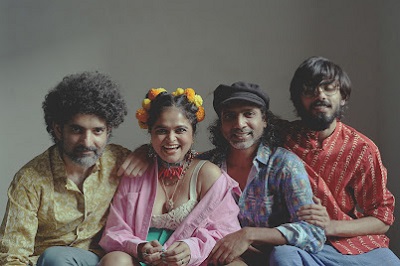New Delhi, (Asian independent) They say it is not intentional that they refuse to be slotted in a genre, just that it is the way they are…That they do not perceive music/art through filters. The TAPI Project group members insist their music is all about dissolving boundaries, labels and boxes.
“It is not only about music or art but the state of the world. We believe reinstating the already-drawn boundary creates deeper ones in people’s minds. Compassion and universality rather than individuality is the way forward,” say members Swati Minaxi (vocals), Yogendra Saniyawala (guitar/lyrics), Gaurav Kapadia (drums), and Biju Nambiar (keyboard/bass).
Launched in 2014, the group, whose sound is a mix of funk and folk on contemporary tribal groove recently released their single ‘Mehsoos’, which is now available across streaming platforms. They will also be performing at the forthcoming Jaipur Literature Festival’s (JLF) Jaipur Music Stage.
Speaking to IANS, lyricist Yogendra Saniyawala recalls that ‘Mehsoos’ came as a sudden realisation — of how badly trapped in the head he was, and numb to the immediate and vivid experience of life.
“Maybe because it is too immediate like the eye cannot see itself. I think it is representative of global consciousness and every one of us goes through it at some point in life,” he says.
Saniyawala adds that the single is an ode to the simple, the mundane, the uncomplicated, and sometimes undecorated things in life, and serves as a reminder that while the world turns and does a spin on us, we still find meaning, love and beauty around us.
Talking about the group’s process, singer Swati Minaxi stresses they try to be aware, transparent and be a medium, let songs take their shape, and try to not chase anything.
“We believe in calling off the search and dissolving. For us, inspiration emerges in the form of tune or poetry from a deeper space. The key is to retain its essence in going through several arrangements, and its (arrangements’) changes. Yes, it’s a very thickly woven process.”
Excited about the kind of collaborations and spillages being witnessed in the art world, when many artists are no longer working in silos — like, painters collaborating with theatre makers, performance artists with writers; and Nambiar feels that the result can be brilliant as all forms came from the space of oneness and the spillage and collaboration is only natural.
“Art and these collaborations pave the way for societies to think beyond norms and, and push sub-cultures to develop, which in turn can create a harmonic and more connected emphatical world. After all, artists are frontrunners and representative of hope.”
Talk to them about how as a band they solve their creative differences, and Kapadia laughs, “By fighting as hard as we can! But also by having a very clear opinion. It is important to note that ‘opinion’ does not come from a space of ego, but rationality. Someone will come up with a point that eventually is agreeable. Sometimes, we need to take a break from each other as well.”
Minaxi feels that the present-day independent music scene in India is growing and is much better than what it was 15 years ago, however, it has a long way to be part of everyday life and make a strong impact on society and culture.
“Independent and mainstream music should become one, and there should be a space for all kinds of music. However, we think we are going towards that kind of culture sooner.”
Considering all members are self-taught and do not come from any discipline, and thus are seldom apprehensive when it comes to trying out new sounds, Saniyawala asserts, “We love to tread dangerous waters.”








